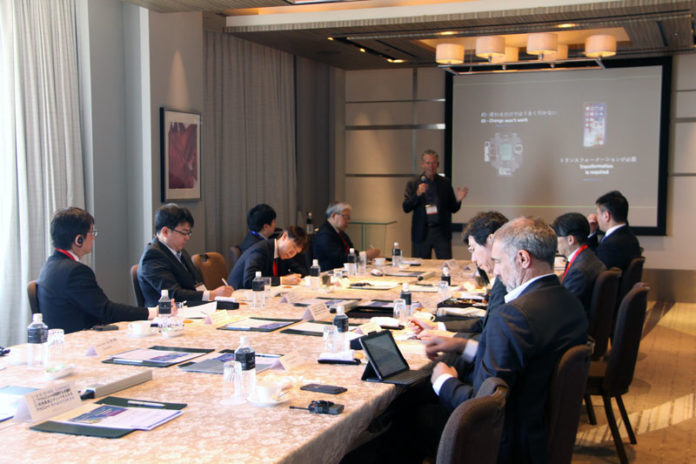Today, many companies are embarking on digital transformation to maintain and improve their competitiveness and contribute to their customers’ digital experiences. However, with the complexity of corporate clouds and the significant impact on operations, this is not an easy task.
Nine senior technology executives from enterprises in Tokyo — including those from a cosmetics company, pharmaceutical companies, medical device companies, and some participants online — gathered to discuss the current status and issues of digital transformation in their organisations. This roundtable in Japan was hosted by Dynatrace and organized by Jicara Media with Tomoharu Nagasawa as moderator.
Digitalization
All companies said that the issues that came up when promoting DX were around systems and awareness, before anything technical came into the picture.
Katsuya Takeuchi, Chief Information Officer, Terumo Corporation explained that domestic Japanese companies have prioritized maintaining their old enterprises systems and that has become an obstacle to current DX. Japan is still behind the curve in promoting DX, compared to overseas. So far, reformation in Japan is done largely in name, by simply changing the name of the legacy system to another. It is necessary to transform the corporate structure that addresses these three pillars: a world-class core system, innovation and information security.
According to the IT executive from a global cosmetics firm, they are focusing on DX in human resource development for all of the company’s employees worldwide, including Japan, so that each one of them will not fail to keep up with the progress of DX. In the case of Shinya Suda, Senior VP of Information System, Astellas Pharma Inc, discovering talent within the company and empowering it was a way of resolving resource issue in their DX.
And ‘everybody’ means not just the employees.
Participants such as Yoshiaki Uwada, Manager of Digital Initiative Department, JGC HOLDINGS CORPORATION commented that the related suppliers and vendors need to change as well. Reforming the awareness of the whole industry is necessary.
Dynatrace CEO John Van Siclen, hosting the event, talked about the question of top-down decision-making in DX. Katsuya Takeuchi said that issues within the corporate structure and low awareness of DX among the companies’ executives — and resource dedication to DX — can be a real problem.
Who takes the lead?
Which department should take the lead to promote DX? It is not just a matter for the IT department alone, but it is necessary to involve all relevant departments in the project.
Yasuo Uesugi, Planning Group Manager of IT Planning Dept, DAIICHI SANKYO CO LTD highlighted their commitment to discussing DX with the managers of all departments. As a result, various matters unrelated to IT were discussed with them as well. He said that the initiative has led to the establishment of a system for the IT department to solve issues throughout the organization, either through IT or digitally.
Tsutomu Urata, General Manager of Digital Business, Isetan Mitsukoshi Ltd said that he has shared the goals and explained what digital transformation is, not just to the IT department, but to all relevant departments such as Marketing and Customer Policy, in order to promote DX within the company. They tried to share their approach as a company, so that other departments will not be left behind while the IT department took the initiative.
This approach seems to have been initiated by the President of the company, and it is clear that top-down movement is important for corporate DX. Yoshiaki Uwada mentioned that without any commitment from the CEO, such as having the CEO become aware of the importance of IT, it would be difficult to promote DX.
But does the top-down approach always work?
“It is important for departments to work together to promote DX, but it cannot be pushed abruptly. Each department has their own goals and budgets in the first place in their annual plan. They cannot just let go of everything to focus on DX. In this case, ‘top-down’ should be done by CxOs and not managers, taking the lead by deciding priorities and allocating resources”, Shinya Suda said.
John Van Siclen narrated the story of a railway company in the United States in terms of the top-down approach and cooperating with other departments. It was an example of the company improving the three aspects of “maintenance”, “safety”, and “cost reduction” by introducing IoT sensors. This was a case that was championed by the CEO of the company, who tried to introduce changes at a fundamental level.
Potential Complications
One of the issues in promoting DX is the unforeseen complications that can arise in the process. DX goes beyond corporate frameworks and touches on customer requirements, along with IT infrastructure.
AI could be a solution to many DX challenges, but the participants generally agreed that AI has played a minor role thus far. Some companies are not yet at the stage of promoting AI internally, and automating operations and digitizing information are priorities at the moment, with the hope of implementing AI in the future.
Van Siclen concluded by emphasizing that “transformation” is more important than “change” when promoting DX. It is necessary to improve on reforming corporate culture and awareness, and cooperation between departments, along with relationships with other companies.
















